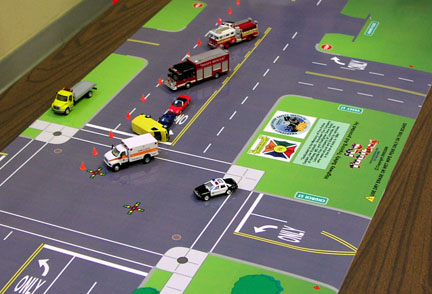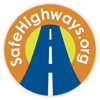Safety Training for Safety Service Patrols
By Rebecca Kanable
“When you step out of the vehicle onto the highway, you’re stepping into harm’s way,” says Jack Sullivan, Director of Training at the Emergency Responder Safety Institute (ERSI). “Many times we assume that because we’ve got a fancy vehicle with flashing lights and maybe an arrow board that that’s enough to protect us. The reality is that motorists today are too distracted.”
Motorists might not see a Safety Service Patrol driver or comprehend what the driver is doing, and the results can be tragic. According to the National Traffic Incident Management Coalition, being struck by vehicles while working alongside the highway is one of the leading causes of death and injury for emergency responders. Move over/slow down laws and public awareness campaigns alone can’t solve the problem. Safety Service Patrol drivers need training that emphasizes safety.
Mark Taylor, Safety Coordinator with the Dallas County Sheriff’s Department in Texas, says safety is the most important part of the job. Courtesy Patrol driver recruits need to know how to properly assist stranded motorists who may need help changing a flat tire or adding coolant to a radiator. While attending to motorists’ needs, these new recruits sometimes have difficulty grasping how important it is to be aware of their surroundings. Taylor emphasizes the operators’ need to make sure they’re not too close to a lane of traffic and, if a vehicle is not in a safe area, the need to move it for their safety and for the safety of the stranded motorist. “It’s important that you show [the driver trainees] how to do something a couple of times, then you let the trainee do it.”
Taylor trains the Courtesy Patrol drivers for 6 to 8 weeks on the road, before they move on to training with a shift trainer for 4 to 6 weeks. Taylor believes field training is the preferred method of training Courtesy Patrol drivers. “It’s really a job where you need to see what’s going on,” Taylor says. “I could tell you all day long how dangerous it is, but until you’re out there standing on the side of a vehicle, you have no idea how dangerous it is. It’s really imperative that the person being trained gets a lot of hands-on experience.”
At the Nebraska State Patrol Headquarters Troop-Lincoln, Community Service Officer Randy Bybee says that prior to on-the-job training, volunteers learn necessities like how to operate the radio and responsibilities like how to complete forms that help to demonstrate the value of the program. The Nebraska Motorist Assist Program (NeMAP) volunteers spend a day and a half on classroom training.
NeMAP volunteers are taught some of the same things as Nebraska State Troopers. Bybee says they train to patrol for stranded motorists, help stranded motorists, assist with traffic control, and above all — stay safe. Because NeMAP volunteers often can be the first ones on the scene of an accident, they need to know how to handle a situation until a trooper arrives on scene. They learn how to park along the side of the Interstate, and to check their mirrors before they get out of their vehicle and keep watch behind them.
NeMAP volunteers receive field training, which Bybee refers to as the “nuts and bolts,” by working with motorist assist program veterans. Since the volunteers will be driving Nebraska state vehicles, they also must take an online defensive driving test. Nebraska State Patrol Public Information Coordinator Deb Collins says the “Defensive Driving- Small Vehicles” course is about an hour long and aims to ensure drivers have the knowledge and techniques to prevent collisions and violations.
The Emergency Responder Safety Institute advocates for an extensive combination of classroom and hands-on experience training. More formal training programs, involving this combination, throughout the country – not only for Safety Service Patrols but for all responders going to roadway incidents – is the ideal (see “Safe Highway Matters” article: Responding to Roadway Incidents and the National Unified Goal & Roadway Incident Scene Safety Outline as provided by the ERSI). In an effort to avoid many of the problems that develop when agencies’ procedures and practices don’t mesh well, the ERSI promotes a multi-agency and multi-jurisdictional approach to initial collaboration and coordination, as well as ongoing communication.
In its classes, the Institute informs students of current standards, roles, laws and other best practices aimed at proper operation at roadway incidents. One resource used in training is “Chapter 6I: Control of Traffic Through Traffic Incident Management Areas” of the Federal Highway Administration’s Manual on Uniform Traffic Control Devices. Many professionals in the transportation arena are familiar with the MUTCD, but many in the public safety sector are not, Sullivan says. For Safety Service Patrol members, state laws and regulations — and in some states OSHA regulations are also important. “OSHA refers back to the MUTCD and anything in the MUTCD that affects SSP workers could be used by OSHA for citations,” explains Sullivan.
Much time is spent talking about personnel safety at an incident scene. Sullivan explains, “We talk about positioning of vehicles and emergency equipment to protect the folks working the incident, the victims of the original incident and the motorists trying to work their way around the incident. We talk a lot about personal protective equipment (PPE), and strategies and tactics for directing traffic around an incident and maintaining a safe work area.” Sullivan recommends Safety Service Patrol drivers familiarize themselves with “Section 6D.03 Worker Safety Considerations” of the MUTCD for more information on PPE.
Many times personnel working at an incident under-estimate the speed of approaching traffic. “They think they can run across a roadway before approaching traffic gets to them,” he says, but when a vehicle is moving 65 mph or faster, a motorist has little time to identify what’s in his/her path and react.

One of the successful training tactics used by the Emergency Responder Safety Institute when training Safety Service Patrol drivers and other first responders. Photo courtesy of ERSI.
One of the successful training tactics ERSI uses to train first responders is the tabletop exercise: A disabled vehicle is on the right-hand shoulder of the roadway. A vehicle is stalled in the left-hand operating lane of a high-speed, limited access highway. Trainees are asked: How do you approach each scene? How do you warn oncoming traffic? The ERSI addressed these and other questions in a webinar titled “The First 15 Minutes: Decision Making at Roadway Incidents.”
Sullivan reiterates the Institute’s stance that the best training practices include classroom as well as practical, hands-on training. He points to Georgia’s Department of Transportation HEROs (Highway Emergency Response Operators) as having exemplary training because their boot camp is very organized. From laws and standards to proper road cone deployment, he says Georgia DOT covers all the bases. (See the HERO Unit Student Training Manual.)
HERO training includes 319 classroom hours and 200 ride-a-long hours. Daniel Hester, Hero Unit Assistant Manager, says, “The importance of so much training is safety, including a basic understanding of the entire anatomy of a highway incident and having the training to help the process of safe, quick clearance.”
Regardless of the jurisdiction and current training practices, Sullivan suggests that Safety Service Patrol drivers, “learn the appropriate steps to take before they ever go out on the highway — that’s much safer.”

